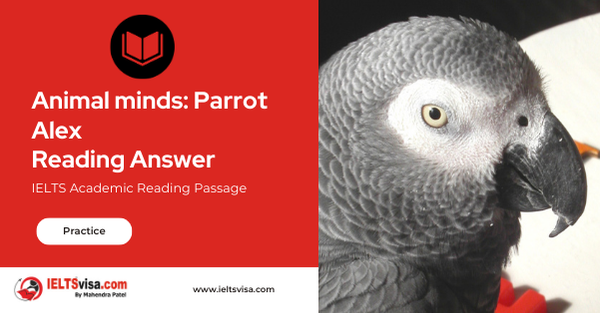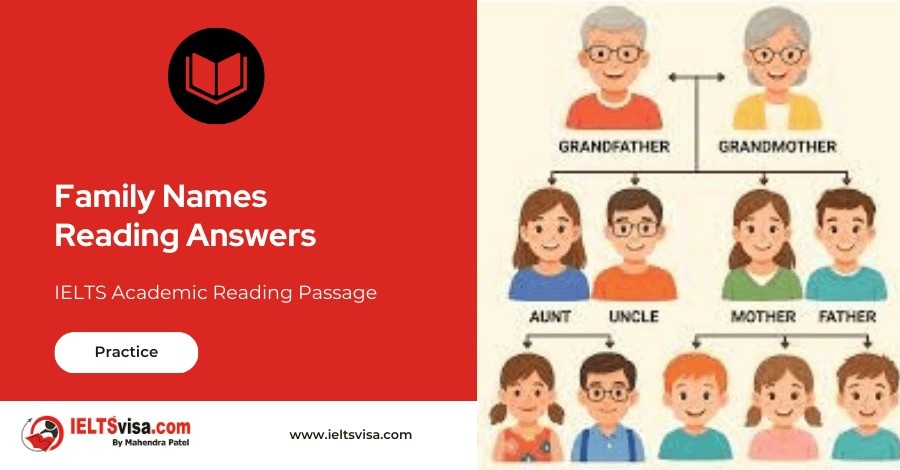Animal Minds: Parrot Alex Reading Answer
IELTS Academic Reading Passage
A
In 1977 Irene Pepperberg, a recent graduate of Harvard University did something very bold. At a time when animals still were considered automatons, she set out to find what was on another creature’s mind by talking to it. She brought a one-year-old African gray parrot she named Alex into her lab to teach him to reproduce the sounds of the English language. “I thought if he learned to communicate, I could ask him questions about how he sees the world.”
B
When Pepperberg began her dialogue with Alex, who died last September at the age of 31, many scientists believed animals were incapable of any thought. They were simply machines, robots programmed to react to stimuli but lacking the ability to think or feel. Any pet owner would disagree. We see the love in our dogs’ eyes and know that, of course, they have thoughts and emotions. But such claims remain highly controversial. Gut instinct is not science, and it is all too easy to project human thoughts and feelings onto another creature. How, then, does a scientist prove that an animal is capable of thinking – that it is able to acquire information about the world and act on it? “That’s why I started my studies with Alex,” Pepperberg said. They were seated – she at her desk, he on top of his cage – in her lab, a windowless room about the size of a boxcar, at Brandeis University. Newspapers lined the floor; baskets of bright toys were stacked on the shelves. They were clearly a team – and because of their work, the notion that animals can think is no longer so fanciful.
C
Certain skills are considered key signs of higher mental abilities: good memory, a grasp of grammar and symbols, self-awareness, understanding others’ motives, imitating others, and being creative. Bit by bit, in ingenious experiments, researchers have documented these talents in other species, gradually chipping away at what we thought made human beings distinctive while offering a glimpse of where our own abilities came from. Scrub jays know that other jays are thieves and that stashed food can spoil; sheep can recognize faces; chimpanzees use a variety of tools to probe termite mounds and even use weapons to hunt small mammals; dolphins can imitate human postures; the archerfish, which stuns insects with a sudden blast of water, can learn how to aim its squirt simply by watching an experienced fish perform the task. And Alex the parrot turned out to be a surprisingly good talker.
D
Thirty years after the Alex studies began; Pepperberg and a changing collection of assistants were still giving him English lessons. The humans, along with two younger parrots, also served as Alex’s flock, providing the social input all parrots crave. Like any flock, this one – as small as it was – had its share of drama. Alex dominated his fellow parrots, acted huffy at times around Pepperberg, tolerated the other female humans, and fell to pieces over a male assistant who dropped by for a visit. Pepperberg bought Alex in a Chicago pet store where she let the store’s assistant pick him out because she didn’t want other scientists saying later that she’d particularly chosen an especially smart bird for her work. Given that Alex’s brain was the size of a shelled walnut, most researchers thought Pepperberg’s interspecies communication study would be futile.
E
“Some people actually called me crazy for trying this,” she said. “Scientists thought that chimpanzees were better subjects, although, of course, chimps can’t speak.” Chimpanzees, bonobos, and gorillas have been taught to use sign language and symbols to communicate with us, often with impressive results. The bonobo Kanzi, for instance, carries his symbol-communication board with him so he can “talk” to his human researchers, and he has invented combinations of symbols to express his thoughts. Nevertheless, this is not the same thing as having an animal look up at you, open his mouth, and speak. Under Pepperberg’s patient tutelage, Alex learned how to use his vocal tract to imitate almost one hundred English words, including the sounds for various foods, although he calls an apple a “banerry.” “Apples taste a little bit like bananas to him, and they look a little bit like cherries, so Alex made up that word for them,” Pepperberg said.
F
It sounded a bit mad, the idea of a bird having lessons to practice, and willingly doing it. But after listening to and observing Alex, it was difficult to argue with Pepperberg’s explanation for his behaviors. She wasn’t handing him treats for the repetitious work or rapping him on the claws to make him say the sounds. “He has to hear the words over and over before he can correctly imitate them,” Pepperberg said, after pronouncing “seven” for Alex a good dozen times in a row. “I’m not trying to see if Alex can learn a human language,” she added. “That’s never been the point. My plan always was to use his imitative skills to get a better understanding of avian cognition.”
G
In other words, because Alex was able to produce a close approximation of the sounds of some English words, Pepperberg could ask him questions about a bird’s basic understanding of the world. She couldn’t ask him what he was thinking about, but she could ask him about his knowledge of numbers, shapes, and colors. To demonstrate, Pepperberg carried Alex on her arm to a tall wooden perch in the middle of the room. She then retrieved a green key and a small green cup from a basket on a shelf. She held up the two items to Alex’s eye. “What’s same?” she asked. Without hesitation, Alex’s beak opened: “Co-lor.” “What’s different?” Pepperberg asked. “Shape,” Alex said. His voice had the digitized sound of a cartoon character. Since parrots lack lips (another reason it was difficult for Alex to pronounce some sounds, such as ba), the words seemed to come from the air around him, as if a ventriloquist were speaking. But the words – and what can only be called the thoughts – were entirely his.
H
For the next 20 minutes, Alex can through his tests, distinguishing colors, shapes, sizes, and materials (wool versus wood versus metal). He did some simple arithmetic, such as accounting the yellow toy blocks among a pile of mixed hues. And, then, as if to offer final proof of the mind inside his bird’s brain, Alex spoke up. “Talk clearly!” he commanded, when one of the younger birds Pepperberg was also teaching talked with wrong pronunciation. “Talk clearly!” “Don’t be a smart aleck,” Pepperberg said, shaking her head at him. “He knows all this, and he gets bored, so he interrupts the others, or he gives the wrong answer just to be obstinate. At this stage, he’s like a teenager; he’s moody, and I’m never sure what he’ll do.”
Questions 1-6
Do the following statements agree with the information given in Reading Passage 1?
In boxes 1-6 on your answer sheet, write
TRUE if the statement is true
FALSE if the statement is false
NOT GIVEN if the information is not given in the passage
1 Firstly, Alex has grasped quite a lot of vocabulary.
2 At the beginning of the study, Alex felt frightened in the presence of humans.
3 Previously, many scientists realized that the animal possesses the ability of thinking.
4 It has taken a long time before people get to know cognition existing in animals.
5 As Alex could approximately imitate the sounds of English words, he was capable of roughly answering Irene’s questions regarding the world.
6 By breaking in other parrots as well as producing the incorrect answers, he tried to be focused.
Questions 7-10
Complete the following summary of the paragraphs of Reading Passage.
Using NO MORE THAN THREE WORDS from the Reading Passage for each answer.
Write your answers in boxes 7-10 on your answer sheet.
After the training of Irene, Parrot Alex can use his vocal tract to pronounce more than 7…………………….. while other scientists believe that animals have no this advanced ability of thinking, they would rather teach 8………………………. Pepperberg clarified that she wanted to conduct a study concerning 9……………………….. but not to teach him to talk. The store’s assistant picked out a bird at random for her for the sake of avoiding other scientists saying that the bird is 10……………………. afterwards.
Questions 11-13
Answer the questions 11-13 below.
Choose NO MORE THAN THREE WORDS AND/OR A NUMBER from the passage for each answer.
11 What did Alex reply regarding the similarity of the subjects showed to him?
12 What is the problem of the young parrots except for Alex?
13 To some extent, through the way, he behaved what we can call him?

Solution: Animal Minds: Parrot Alex Reading Answer
| 1. NOT GIVEN | 9. Avian cognition |
| 2. NOT GIVEN | 10. particularly chosen |
| 3. FALSE | 11. color |
| 4. TRUE | 12. wrong pronunciation |
| 5. TRUE | 13. teenager |
| 6. FALSE | |
| 7. 100 English wordS | |
| 8. chimpanzees |
Review and Practice
- Regularly practice with IELTS reading samples and time yourself to get used to the pressure of the exam.
- Review your mistakes to understand where you went wrong and how to avoid similar errors in the future.
Our Books
Master IELTS Speaking Part 1
IELTS Writing Task 1 Book
IELTS Writing Task 2 Book
Animal minds : Parrot Alex Reading Answer Explanation
| Question NO | Question Type | Answer | Keywords | Supporting Sentence | Location of Keywords | Explanation |
|---|---|---|---|---|---|---|
| 1 | True / False / Not Given | NOT GIVEN | – | “If Alex, the parrot, had picked up quite a bit of vocabulary, it is nowhere to be seen.” | – | The claim about Alex’s vocabulary is not clearly confirmed, so the answer is NOT GIVEN. |
| 2 | True / False / Not Given | NOT GIVEN | – | “Pepperberg and Alex are described as ‘obviously a team’…” | – | There is no direct statement confirming whether Alex was scared of people, making this statement NOT GIVEN. |
| 3 | True / False / Not Given | FALSE | scientists, animal, incapable, thought, lacking, automatons | “Prior to Pepperberg’s investigation into Alex’s worldview, scientists held the belief that animals lacked the capacity for thought and emotion.” | Paragraph A, 2nd line; Paragraph B, 1st and 2nd line | Scientists once believed animals lacked thought and emotion, which contradicts the claim, so the answer is FALSE. |
| 4 | True / False / Not Given | TRUE | 1977, automatons, Thirty, years, cognition | “In 1977 Irene Pepperberg, a recent graduate of Harvard University…” | Paragraph A, 1st and 2nd line; Paragraph D, 1st line; Paragraph F, 7th line | The timeline shows that it took 30 years for the understanding of animal cognition to develop, confirming the statement is TRUE. |
| 5 | True / False / Not Given | TRUE | approximation, sounds, English, world | “Because Alex was able to produce a close approximation of the sounds of some English words…” | Paragraph G, 1st line | Alex’s ability to mimic English sounds allowed for questions about his understanding, so the answer is TRUE. |
| 6 | True / False / Not Given | FALSE | interrupts, obstinate, moody, bored | “He knows all this, and he gets bored, so he interrupts the others…” | Paragraph H, 6th and 7th line | Alex interrupted due to boredom and moodiness, showing he was not simply obstinate but had behavioral changes, so FALSE. |
| 7 | Complete the following | 100 English words | one hundred, English, words, vocal tract | “Alex learned how to use his vocal tract to imitate almost one hundred English words…” | Paragraph E, 6th line | The correct answer is 100 English words because Alex was trained to mimic almost one hundred words. |
| 8 | Complete the following | chimpanzees | chimpanzees, subjects, communicate | “Scientists thought that chimpanzees were better subjects…” | Paragraph E, 2nd and 3rd line | Chimpanzees were considered better subjects for communication studies but couldn’t speak, so the correct answer is chimpanzees. |
| 9 | Complete the following | avian cognition | human language, avian cognition | “My plan always was to use his imitative skills to get a better understanding of avian cognition.” | Paragraph F, 5th and 6th line | Pepperberg’s goal was to study avian cognition, not human language, so the answer is avian cognition. |
| 10 | Complete the following | particularly chosen | assistant, pick, scientists, particularly chosen, smart bird | “Pepperberg let the store’s assistant pick him out…” | Paragraph D, 5th line | Alex was not specially chosen for his intelligence to avoid criticism, so “particularly chosen” is the answer. |
| 11 | Answer the questions | color | color | “What’s same?” she asked. Without hesitation, Alex’s beak opened: “Co-lor.” | Paragraph G, 7th line | Alex recognized colors, so the answer is color. |
| 12 | Answer the questions | wrong pronunciation | wrong, pronunciation | “Talk clearly!” he commanded, when one of the younger birds… talked with wrong pronunciation. | Paragraph H, 4th line | Alex corrected mispronunciations, so the answer is wrong pronunciation. |
| 13 | Answer the questions | teenager | bored, interrupts, teenager, moody | “He’s like a teenager; he’s moody, and I’m never sure what he’ll do.” | Paragraph H, 6th and 7th line | Alex’s behavior was compared to a teenager, being moody and unpredictable, so the answer is teenager. |
Practice IELTS Other Modules
IELTS Listening
The IELTS Listening test assesses how well you can understand spoken English in various contexts. It lasts about 30 minutes and is divided into four sections with a total of 40 questions. The listening tasks become increasingly difficult as the test progresses.
IELTS Academic Reading
The IELTS Academic Reading section assesses your ability to understand and interpret a variety of texts in academic settings. It is designed to evaluate a range of reading skills, including skimming for gist, reading for main ideas, reading for detail, understanding inferences, and recognizing a writer's opinions and arguments.
IELTS Speaking
The IELTS Speaking test assesses your ability to communicate in English on everyday topics. It lasts 11-14 minutes and consists of three parts: introduction, cue card, and a discussion based on the cue card topic.
IELTS General Reading
IELTS General Reading tests your ability to understand and interpret various types of texts. Here are some key areas and types of content you can expect to encounter in the reading section, along with tips for effective preparation.
IELTS Academic Writing Task 1
In IELTS Academic Writing Task 1, you are presented with a visual representation of information, such as graphs, charts, tables, or diagrams, and you are required to summarize, compare, or explain the data in your own words.
IELTS General Writing Task 1
In IELTS General Writing Task 1, you are required to write a letter based on a given situation. The letter can be formal, semi-formal, or informal, depending on the prompt. Here’s a breakdown of the key components to include in your letter
IELTS Academic Writing Task 2
In IELTS Academic Writing Task 2, you are required to write an essay in response to a question or topic. Here’s a guide to help you understand the essential elements of this task
IELTS Exam Tips
To succeed in the IELTS exam, practice regularly, familiarize yourself with the test format, improve your vocabulary, develop time management skills, and take mock tests to build confidence.
Grammer for IELTS
Grammar is the foundation of effective communication in English. Understanding tense usage, subject-verb agreement, and sentence structure enhances clarity and coherence in writing and speaking.
Vocabulary for IELTS
Vocabulary plays a crucial role in the IELTS (International English Language Testing System) exam, especially in the Speaking and Writing sections. Here’s an overview of why vocabulary is important and how it impacts your performance
RECENT IELTS SAMPLES QUESTIONS AND ANSWERS
Cubism
When the name of Picasso is spoken, the concept of ‘Cubism’ usually springs to mind. That this...
If You Can Get Used To The Taste
A. There is a formal word for it: entomophagy. It means the consumption of insects by us,...
From SunnyD and Pizza to Bread and Water
A. Another bad week in a bad month for the food and drink industry. Sunny Delight, formerly...
Family Names
A Any specific study of words and language almost invariably has an obscure name, and that...
Coming of Age
A Three striking facts highlight the dramatic shift in recent years in the relative economic...
Britain’s canals – the solution to overcrowded roads?
A. It's hard to imagine that only a decade or so ago many of the nation's canals were little...













